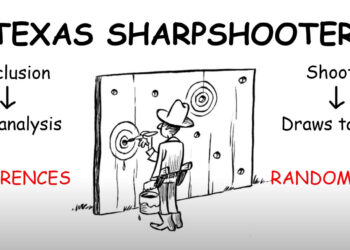
Is the world moving in a way that may naturally heal the editorial-business divide?
This divide has been a constant in all areas of publishing, perhaps none as famously as scientific publishing. Some battles in our fields have lit up headlines over the years as publishers and editors have squabbled over high-end concepts like “independence” and “viability.” Aside from these fireworks, I’ve worked at and been able to visit a number of scholarly publishers in my career, and I’ve seen this divide far too often. Even titles as commercial as the Economist are portrayed as divided, as in a recent profile in the Guardian:
. . . [as] with every title, there is a separation between church and state
Sometime, I think I’ll devote some time to figuring out which is church, which is state, and why. But that’s for another day.
As a publisher who came up as much through editorial as through business, walking this borderland dividing editorial and business has been interesting. The lack of respect on each side can be stunning, but the need for each other is undeniable.
There are many editorial-business or science-business hybrids employed in publishing, but not as many as we might want or need now, and especially into the future. These people are the shuttle diplomats in many organizations, able to touch most issues with knowledge and experience, but never fully part of either camp. They’re the generalists. To people like this, the divide is sometimes shocking when it opens wide enough for them to feel it. They can easily forget it exists at all — until some strange behavior reminds them of the perverse power those wielding such divisiveness can invoke.
The divide between editorial and business seems to be strongest when publications are stagnant and successful. Success can lead to editorial and publishing offices that are overly formalistic, set in their ways, and over-confident of the path forward. Success and stability can quickly become lassitude, hubris, or arrogance. During such times, energies normally expended to humbly compete for audience, implement compelling new editorial ideas, secure stable business, and bring in revenues turns inward. Good times also give the illusion of enduring power structures inside the building, a scaffolding to compete over and within.
Editors often work outside of the publishing offices — in remote locations using a staff devoted to editorial. In the issue economy, when discrete content items were gathered together into issues and those issues were sold, that was fine. Even in the article economy, it was acceptable — issues became sets of articles, not a huge change. But in the attention economy, publishing an article isn’t enough. More is required.
There’s an intrinsic pecking order to the classic divide — editorial first, business second. Because editorial is viewed as intrinsically superior to business, governance bodies often make the mistake of thinking that editorial should be at the vanguard of the organization. This is essentially an extension of the “editorial fallacy” Joe Esposito analyzed a couple of years ago:
The editorial fallacy is the belief that all of a publisher’s strategic problems can be solved by pursuing and publishing the finest books and articles.
But an interesting change has occurred over the past decade, a change our power structures, governance practices, and work habits haven’t yet fully absorbed. Gradually, implacably, we are now almost always in launch or development mode, but on a smaller scale than before. Each article needs to be launched to its audience to receive the attention it deserves. Each issue has to fight for attention, which requires publishing expertise from editors and editorial expertise from publishers. Editors have to behave more like publishers, and publishers have to support and cultivate editors in new ways.
The old divide can now be stitched closed by everyone focusing on an ever-more elusive and fickle information consumer.
Data on actual readership has replaced the presumptions of print — in print, there was a lingering conceit that every article was savored by an audience craving its rarefied contents. Now, editors can know when an article has received zero — yes, zero — views or downloads. This is new and sometimes shocking information, but knowledge of actual uptake is becoming commonplace. Is it affecting editorial behavior? Sometimes, in some places. But there’s still enough of a veneer of print that online data can be viewed as anomalous. This won’t last, and editors will become more interested in controlling the destinies of their content.
At the same time, publishers can’t practice their craft as if content is simply delivered, fixed in a final form, and scheduled. More and more publishing is occurring on networks like Twitter and Facebook, and commenting is slowly gaining legitimacy. New editors are needed for these outputs, and this requires new support systems and talent. New media sources, curation techniques, and business models require closer collaboration with domain experts and editors.
Technology has quickly moved from being a distribution alternative to being a creative medium of vast potential. Video, audio, animations, data displays — the editorial potential is rich here, but as long as editors continue to view technology as something their publishers use to get their content out, this palette won’t be exploited.
Marketing, analytics, product development, business development, editing, composition, technology — these are the tools editors and publishers should both be wielding to succeed in a more competitive information sphere. To confine them along a familiar border merely out of a need for traditional structures — including the editorial-business divide — can be counterproductive.
Editors and publishers are working in the midst of a time of great change. Editors are no longer capable of creating unique resources that can’t be integrated into even more useful resources. Overlays like Google, PubMed, and other overlays provide every online site with most of its traffic. Publishers are no longer able to work at arm’s length. Editors have to come up with new ideas that fit the times, and publishers need to give them the space, support, and perspective to do so. To succeed, a new level of collaboration needs to emerge.
Those who still embrace the editorial-business distinction are living in a past in which content was fixed, audience interactions took months to occur, publishing infrastructure didn’t allow for echoes to be more powerful than the source, and content didn’t remix with other content on a daily basis. The path forward in one of synthesis, finding paths into workflows and attention zones, and aligning with an audience.
A house divided cannot stand, but both sides will surely sink if built for land and then put to sea.
Discussion
11 Thoughts on "Healing the House Divided — A Side-Effect of Shifting to the Attention Economy?"
You can be the church of change and I will be the state of affairs. You lost me when you started talking about publishing journals on Twitter. After that you shift into future tense, more of a sermon than a description. “Change or be damned (a beautiful future awaits).”
Change is an opportunity but also a problem. The first order of business is not to get knocked off and running forward in all directions is a good way to lose the race. The technology is lots of fun, but very expensive, and I don’t see the core business changing. We are already at sea and rebuilding a ship at sea is tricky business.
I do agree that publishing and editorial need to work closely together in deciding what changes to make, and especially what not to make, much more closely than during steady state conditions. Perhaps this is your point. But that is because change is always risky and risk is a business decision. So the divide does not go away, rather it becomes much more active.
My main point is in accord with your ultimate summation — the divide becomes much more active because getting attention is much less certain, requires more skills for editors and publishers (skills the other possesses), and we’re in a constant “launch mode” rather than steady state. Change is fraught with risk, but risk is not a business decision purely — risky editorial gambles can pay off and change business _if_ the business is able to realize the potential (i.e., not catering to the “house divided” model).
The divide exists, and it’s absurd to think that one side can think it’s “winning” when the only casualty is reputation to an audience. Talk about your Charlie Sheen problems!
Rhetorical flourishes aside, you and I agree on most things. My work typically involves acting as a translator across this divide, between the business and the creative sides, which speak different languages. It takes a lot of reciprocal effort to narrow down the wild sea of possibilities into a realistic action plan. Tempers run high and it is easy to fall into an us-versus-them trap. Confusion is the price of progress, and that is the real divide.
In my experience, the strongest editorial/business divide occurs in newspaper publishing. (I served on the board of directors of a college newspaper for nine years.) Editorial was not to be influenced at all by advertising the business division brought in, so that a critical article might be published about a company that was the paper’s best advertiser. At Penn State Press, by contrast, the divide did not manifest itself much at all. We did journal publishing primarily for business reasons, viz., that the surpluses we made from publishing journals helped subsidize the publication of monographs. In publishing monographs, there was no question that editorial was king. That primacy manifested itself, among other ways, in publishing books in hardback at prices as low as possible and in maximizing the number of copies distributed (through paperback publication) rather than maximizing the return on each unit sold. European commercial academic publishers, by contrast, typically publish hardbacks at very high prices, seeking to maximize revenues from library sales alone, and caring little about how affordable the books are to individuals.
Newspapers are a funny place to have this divide occur so strongly (and I agree, it is strong at papers), because the layout of a paper is ultimately driven by ad space — copy is allocated based on how much space needs to be filled so that it’s not all advertising. But the “editorial vs. advertising” framework may have been trumped by something else at newspapers.
There’s an interesting book review in last week’s New Yorker about Howard Cosell. David Remnick observes that because most TV networks have big sports contracts with the NFL, NBA, NCAA, or MLB, their sports reporting has devolved to adulation (e.g., LeBron James’ “The Decision” as the worst example of this). Cosell was abrasive and frank, and asked hard questions. Newspapers have become victims of the same type of corporate blankets — owners who are in so many industries that the ad department isn’t the source of conflict, the owners are. They may not care whether their advertisers are upset. They may care more if their other holdings are damaged.
I thought that one of the most interesting comments here was not about Twitter or alternative technologies, but about the future of academic journals themselves:
“Data on actual readership has replaced the presumptions of print — in print, there was a lingering conceit that every article was savored by an audience craving its rarefied contents. Now, editors can know when an article has received zero — yes, zero — views or downloads. This is new and sometimes shocking information, but knowledge of actual uptake is becoming commonplace. Is it affecting editorial behavior? Sometimes, in some places. But there’s still enough of a veneer of print that online data can be viewed as anomalous. This won’t last, and editors will become more interested in controlling the destinies of their content.”
Insofar as journals are businesses, how long can one survive when use statistics from online resources can identify to academic librarians that, no matter what the reputation of a journal, no one is reading it? And what of web-scale discovery tools such as Summon or Ebsco Discovery which search a central index and not a journal? These tools are blind to a journal’s reputation and focus on an index search that meets the need of a user from many sources. I know that many faculty basically read only the specific journals in their specialty, but the majority of undergraduate academic library users (when they use library resources at all!) are not targeting a particular journal — they’re looking for an article that will meet a particular need. I wonder how this, as well as something like patron-driven acquisition (in which a library only pays for a book when it is used) will affect the future of academic publishing?
This is a very interesting point. Are usage data ever made available for subscription journals, or is it only OA journals that make this info public?
Readership importance (impact) is presently measured by citations. Web usage might change that, but it is an iffy metric. In any case it is unlikely that the leading journals are not read.
Librarians, however, do not only measure importance by impact factors; use is actually more important. Impact factors tend to be more important in faculty tenure and promotion decisions (and number of citations is a questionable enough way of identifying intellectual importance, anyway!). What matters to me is that there is evidence that a resource is used and valuable to the students at my university as well as to faculty. When there are budget cuts and I have to make decisions about what to retain and what to cancel, I will be checking use statistics, not impact factors, as the primary statistic.
While it may be true at present that it is “unlikely that the leading journals are not read,” it seems to me quite likely that web scale discovery searching will distribute searches based more on subject relevance than on a journal’s reputation and this could actually introduce a wrinkle into the question of a journal’s “impact” that would not be answered by the question “How many times was it cited by other academics?” This, in turn, could certainly have an impact on journals that are currently regarded as untouchable in their importance.
I am all for using these usage metrics but they raise some complex issues of interpretation. Student usage in particular. One would think that student research is driven by classwork, hence by the faculty. But I can see how it might be wide ranging. I would be interested in this data in terms of the demographics and dynamics of attention (what is hot with whom).
But before I used this usage data for acquisition decisions I would want to know how transient it is. One acquires a journal for future years, not just today’s hot topics. But in principle I agree with your concept. Kent is correct that having this kind of data is potentially very important. How to use it is less clear but that is the way with revolutions. Confusion is the price of progress.



